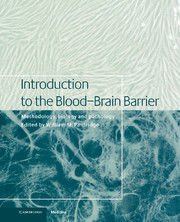Book contents
- Frontmatter
- Contents
- List of contributors
- 1 Blood–brain barrier methodology and biology
- Part I Methodology
- Part II Transport biology
- 18 Biology of the blood–brain glucose transporter
- 19 Glucose transporters in mammalian brain development
- 20 Blood–brain barrier amino acid transport
- 21 P-glycoprotein, a guardian of the brain
- 22 Blood–brain barrier ion transport
- 23 Ion channels in endothelial cells
- 24 Interactions of lipoproteins with the blood–brain barrier
- 25 Fatty acid and lipid intermediate transport
- 26 Blood–brain barrier transport of drugs
- Part III General aspects of CNS transport
- Part IV Signal transduction/biochemical aspects
- Part V Pathophysiology in disease states
- Index
18 - Biology of the blood–brain glucose transporter
from Part II - Transport biology
Published online by Cambridge University Press: 10 December 2009
- Frontmatter
- Contents
- List of contributors
- 1 Blood–brain barrier methodology and biology
- Part I Methodology
- Part II Transport biology
- 18 Biology of the blood–brain glucose transporter
- 19 Glucose transporters in mammalian brain development
- 20 Blood–brain barrier amino acid transport
- 21 P-glycoprotein, a guardian of the brain
- 22 Blood–brain barrier ion transport
- 23 Ion channels in endothelial cells
- 24 Interactions of lipoproteins with the blood–brain barrier
- 25 Fatty acid and lipid intermediate transport
- 26 Blood–brain barrier transport of drugs
- Part III General aspects of CNS transport
- Part IV Signal transduction/biochemical aspects
- Part V Pathophysiology in disease states
- Index
Summary
Introduction
During the past decade there has been remarkable advancement in our knowledge about the molecular components involved in the fundamental biological function of membrane transport, the movement of a molecule (or two different molecules as in co-transport) from one side of an impermeable biological membrane to the other side. Despite these advancements, scientists only now are poised to discover the answers to key questions regarding the actual mechanism of transport of simple hydrophilic molecules, the regulation of intrinsic transporter activity, the pathways of intracellular trafficking of transporters and their targeting to specific plasma locations, and the factors that signal transporter expression in a cell-specific and a temporal-specific manner.
The system of glucose transport in the brain ranks with high importance in neuroscience because of two fundamental observations made previously. First, the brain exhibits a nearly exclusive appetite for blood-borne glucose to sustain a high rate of aerobic metabolism. Secondly, the brain vasculature is lined with a layer of endothelial cells that form tight junctional contacts and thus prevent any gaps or spaces between cells that would allow for the free movement of blood-borne glucose (or other hydrophilic substances) into the brain extracellular space.
- Type
- Chapter
- Information
- Introduction to the Blood-Brain BarrierMethodology, Biology and Pathology, pp. 165 - 174Publisher: Cambridge University PressPrint publication year: 1998
- 11
- Cited by



